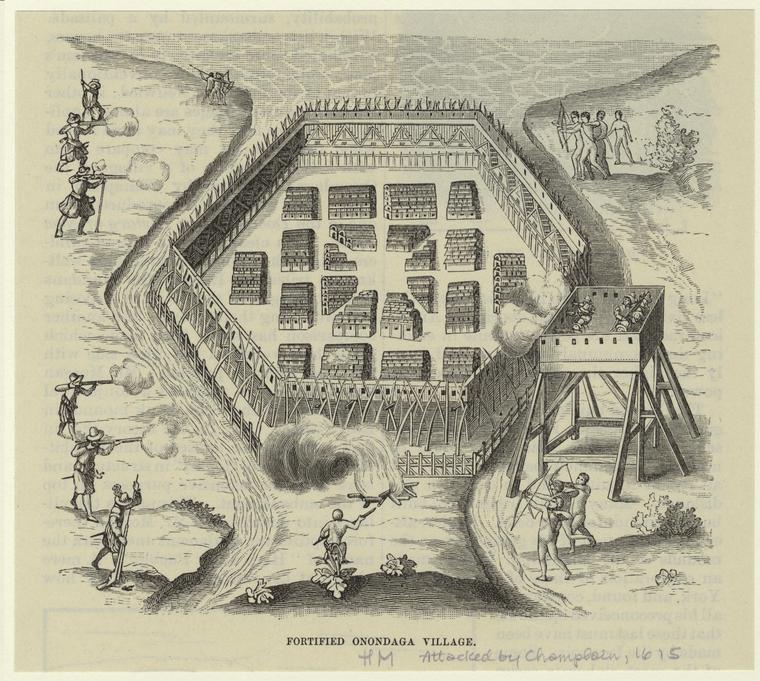Maxime Gohier, professor at the Université de Québec à Rimouski, specialist in indigenous political history
While France’s alliances with Indigenous peoples were essential to their colonization efforts in North America, the development of New France was also marked by major conflicts which occupied an important place in the documents produced during the French regime. The incursion of the French into Indigenous territories exacerbated existing conflicts and helped create new ones.
Indigenous Peoples and War
As noted by several writers, including the Jesuit Joseph-François Lafitau (1724), war held an important place in Indigenous cultures as a way of ensuring the social reproduction of their traditional societies. To establish themselves in America, the French, therefore, had to navigate a series of pre-existing rivalries and alliance networks.
The writings of Jacques Cartier (1534 and 1536) depict several of these rivalries and attest to the explorer’s inability to grasp the geopolitical dynamics particular to the Saint Lawrence Valley. This confusion undoubtedly contributed to the failure of France’s colonial endeavours in the 16th century.
Wars with the Haudenosaunee
In contrast, during the 17th century, the French were able to establish the foundations of a colony by involving themselves in Indigenous conflicts. Allying with the Innu (Montagnais), the Omàmiwininiwak (Algonquin) and the Wendat (Huron), Samuel de Champlain became a part of their conflict against the Haudenosaunee Confederacy (Iroquois or Five Nations) when he launched his first raid against them in 1609. The resulting conflict lasted until 1701 and deeply marked the development of the colonial project, for it was through their promises to protect other Indigenous nations from the Haudenosaunee Confederacy that France was able to establish a wide-ranging network of alliances that helped ensure the survival of its colony until 1760.
From Evangelisation to Militarisation
To understand the evolution of these wars with the Haudenosaunee, historians have relied heavily on documents produced by French protagonists, with all the biases this implies. In the early 17th century, reports of these conflicts were mainly drafted by the Jesuits in their annual
Relations. As of 1660, the correspondence of colonial administrators can be added to this corpus, as can texts written by military officers sent from France to “pacify,” if not destroy, the Haudenosaunee. The regiment of Carignan-Salières, which arrived in 1665, then, as of 1683, the
Compagnies Franches de la Marine, made incursions into “enemy” territory, at times with the support of Indigenous allies and Canadian militiamen; they also constructed a series of forts, and documented the organisation of Haudenosaunee territory. Even more than European rivalries, it was thus the wars against the Haudenosaunee that led to the militarisation of New France. In fact, these wars marked colonial history to such an extent that they made up the essential part of the
Histoires published in the 18th century by
Bacqueville de La Potherie or
Charlevoix and are the subject of a fairly extensive
iconography.
Traces of Peacemaking
Writings produced in New France also devoted considerable space to peace negotiations with the Haudenosaunee. More than ten treaties were concluded between 1609 and 1701, and they are vital to understanding the motivations behind the wars or the incitements to peace. Champlain’s
Œuvres (1624) and several volumes of the Jesuit
Relations (1641, 1645 and 1653) contain traces of oral treaties which, following Indigenous diplomatic culture, were sealed by an exchange of gifts and
wampum belts. When treaties were ratified in writing, as with the Great Peace of Montreal (1700 and 1701) or the treaties of 1665-1666, they appear in official documents, sometimes signed by Indigenous ambassadors, with more detailed contents and in a singular form.
The 18th Century: War and Slavery
Because of their duration (a century) and their impact on colonial development, wars with the Haudenosaunee have tended to overshadow other conflicts. The 18th century, in particular, witnessed its fair share of antagonisms, whose outcomes were far more tragic for the Indigenous populations. For example, between 1712 and 1738, under pressure from their allies, the French launched a genuine war of extermination against the Fox (Meskwaki). The Natchez Revolt, in Louisiana, is more widely familiar, thanks in part to the writings of Châteaubriand. For a good twenty years, French colonists had cohabited with this nation, whose social and political organisation reminded them of European societies. The causes of the sudden attack by the Natchez, in 1729, on the French garrison and settlers at Fort Rosalie are complex even if sources underline the existence of a land dispute. This event triggered bloody reprisals by the French troops which led to the virtual extinction of the Natchez. As a few Natchez survivors had taken refuge with the Chicachas, the French launched several expeditions against that nation in 1736 and later on in 1739 and 1740. Dumont de Montigny, who had lived with the Natchez and taken part in the campaign of 1736 against the Chicachas, noted that these raids gave the French army and militia the opportunity to capture Indigenous people and then reduce them to the state of enslaved people. This was in fact a distinctive aspect of the Franco-Indigenous conflicts in the 18th century: as war captives became enslaved peoples within colonial societies, tensions with the captives communities of origin festered.
As violent as they were, these conflicts did not deter many other Indigenous nations from maintaining their alliances with the French. Indeed, the rapid growth of the British colonies, which threatened Indigenous territories, encouraged many nations to join forces with New France until the final moments of the
Seven Years’ War.
Published in may 2021


